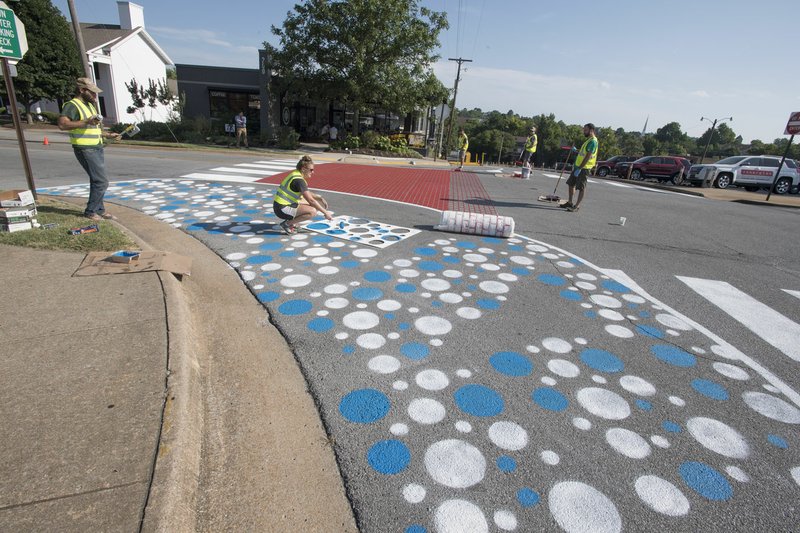FAYETTEVILLE -- A pair of volunteer-led intersection projects slowed traffic for pedestrians but had a few unforeseen issues, serving their experimental purpose, city transportation officials said Tuesday.
The Transportation Committee, consisting of half the City Council, reviewed the findings of two impermanent projects created under the city's tactical urbanism program. The city initiated a test of the program last summer, which allows residents to submit ideas for street projects that then run through various departments before approval. The volunteers build the features with low-cost, temporary material such as paint, artificial grass and plastic markers.
One project put stop signs facing all three directions of traffic at Rock Street and Mill Avenue, reduced the wide turn and featured crosswalks painted in bright colors. Another put in crosswalks at Church Avenue and Center Street and extended the curb on the northwest corner with paint.
Both projects resulted in cars moving slower, according to the data. Of the 227 cars that went through the Rock Street and Mill Avenue intersection for a two-hour period Aug. 18, before the installation, 16 appeared to speed. After the installation, zero of 260 cars on Aug. 29 appeared to speed with three out of 271 cars appearing to speed Oct. 5.
The percentage of speeding cars reduced from 7 to 0, or 1 percent. However, 50 to 56 cars didn't come to a full stop or rolled through the newly installed stop signs at Rock Street and Mill Avenue.
City Engineer Chris Brown said such a practice is common with no other traffic to contend with. About 80 percent of cars complied with the traffic markings. The intersection caused confusion before because one leg had a yield sign, another had a stop sign and the third had nothing at all, he said.
One resident who spoke during Tuesday's meeting, Stan Lancaster, said the experiment failed. The installation impeded the flow of traffic and wasn't warranted, he said.
"I can count on my fingers the number of pedestrians I have seen attempting to cross there in the last 10 years," Lancaster said.
Alli Quinlan, a planning commissioner who spearheaded the Mill Avenue and Rock Street project, said part of the purpose was to help children going to the Yvonne Richardson Community Center safely cross the street.
Victoria Carney, another nearby resident, said she wants her 5-year-old son to be safe from cars barreling down that intersection when he gets older.
"We live there and want a safe community. We deserve a safe community," she said. "We want to be able to go for a walk and not have to run from traffic."
The committee didn't vote but advised city staff to make a few minor modifications and look into designing something permanent in the future.
Several comments submitted to the city on the Church Avenue and Center Street project noted the difficulty fire trucks had in maneuvering through the intersection's tight turns, other cars and buses. Eleven of 20 respondents rated it as highly unfavorable.
Of the 746 vehicles observed July 25, before the installation, 653, or 87 percent, complied with traffic markings. That number rose to 97 percent after volunteers painted crosswalks and extended curb at the intersection, according to the data.
Before the installation, 90 cars, or 12 percent, appeared to speed. The number reduced to five out of a counted 576 on Aug. 8, or 1 percent. Kelsey Miller with BikeNWA said apparent speed was measured by how quickly a vehicle approached a stop and whether a pedestrian would feel safe enough to cross.
Council Member Matthew Petty, committee chairman, said he wanted to see the crosswalks stay. He recommended staff review the extended curb lines.
NW News on 01/31/2018

